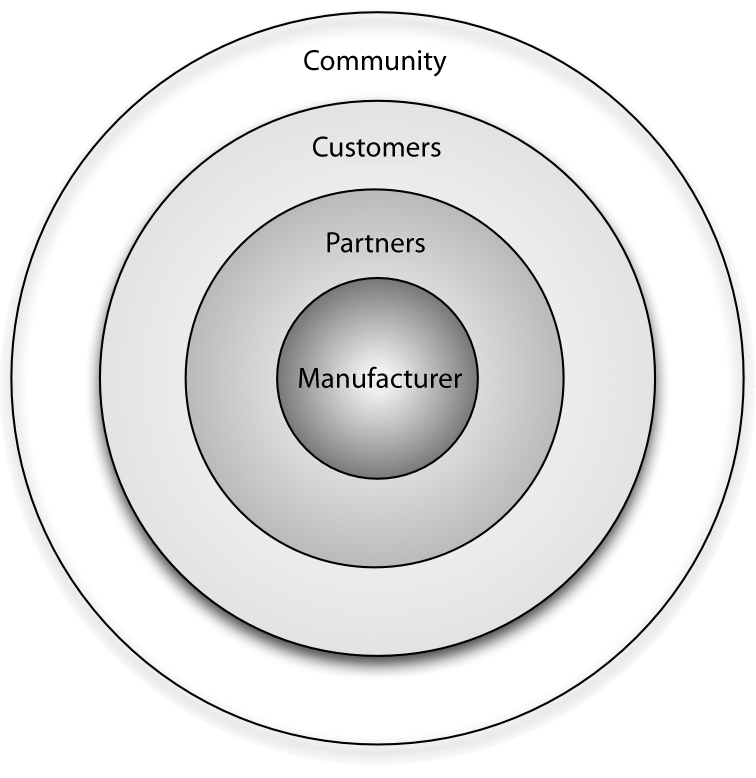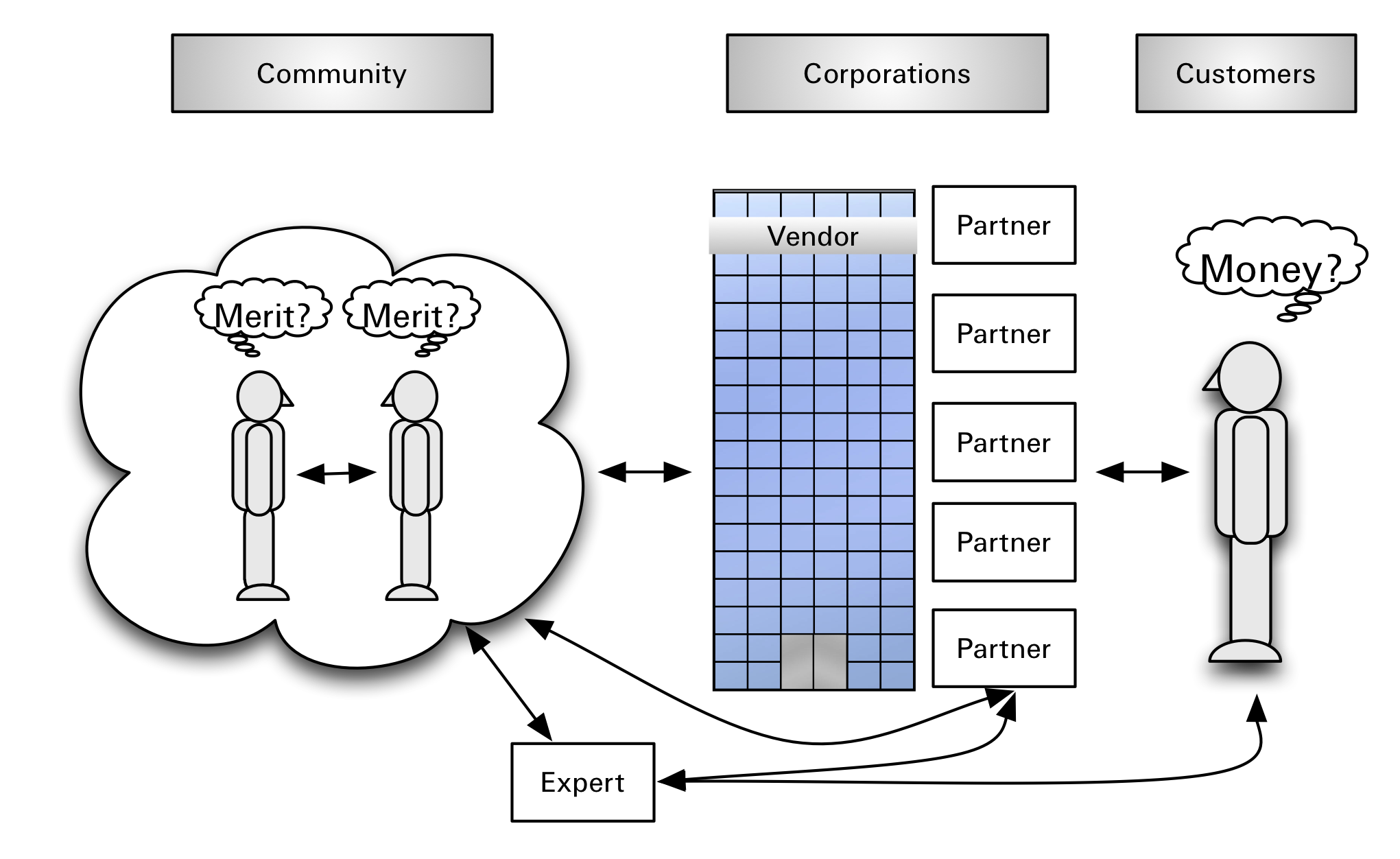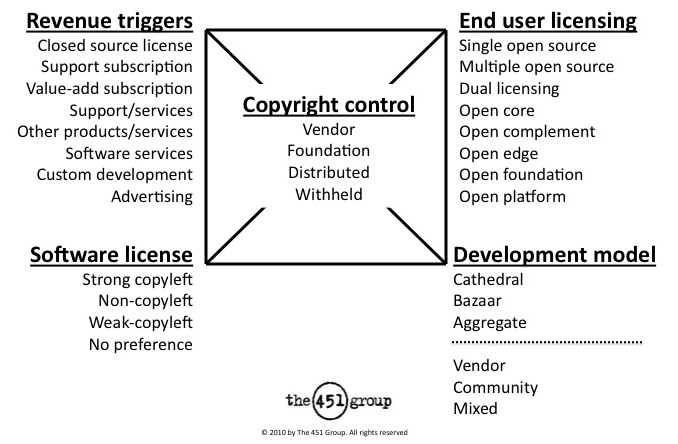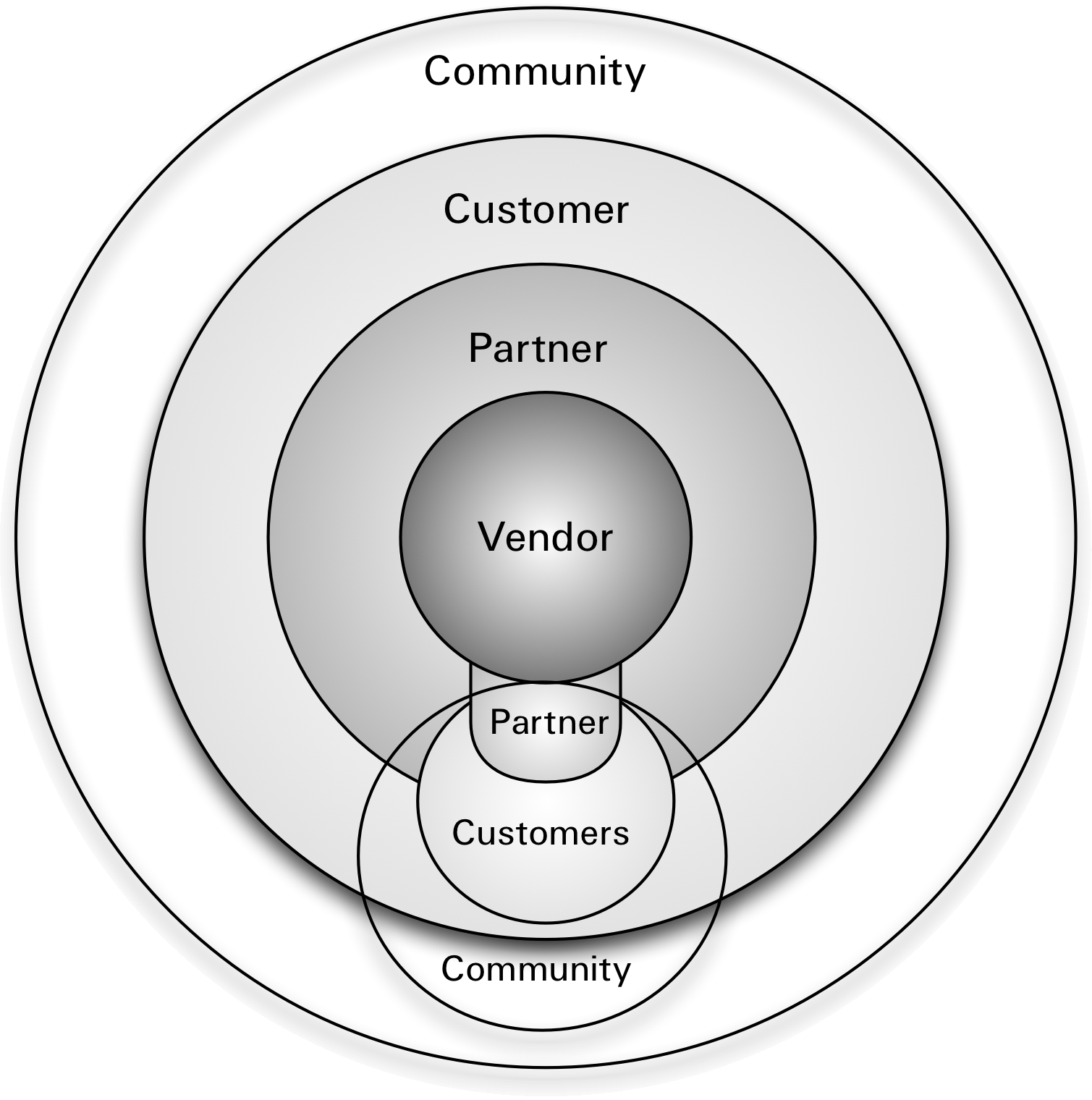Journal:Benefits of the community for partners of open source vendors
| Full article title | Benefits of the community for partners of open source vendors |
|---|---|
| Journal | Open Source Business Resource |
| Author(s) | Groganz, Sandro |
| Author affiliation(s) | Age of Peers Ltd., CampaignChain, Inc. |
| Primary contact | Web: http://sandro.groganz.com/contact/ |
| Year published | 2011 |
| Volume and issue | August 2011 |
| Distribution license | Creative Commons Attribution 3.0 Unported |
| Website | http://timreview.ca/article/463 |
|
|
This article originally appeared in an online magazine and is not a traditional journal article, thus the lack of citations. |
"The most important single central fact about a free market is that no exchange takes place unless both parties benefit." - Milton Friedman
Abstract
Open source vendors can benefit from business ecosystems that form around their products. Partners of such vendors can utilize this ecosystem for their own business benefit by understanding the structure of the ecosystem, the key actors and their relationships, and the main levers of profitability. This article provides information on all of these aspects and identifies common business scenarios for partners of open source vendors. Armed with this information, partners can select a strategy that allows them to participate in the ecosystem while also maximizing their gains and driving adoption of their product or solution in the marketplace.
Introduction
Every free/libre open source software (F/LOSS) vendor strives to create a business ecosystem around its software product. Doing this offers two primary advantages from a sales and marketing perspective: i) it increases the viability and longevity of the product in both commercial and communal spaces, and ii) it opens up new channels for communication and innovation.
Access to source code, coupled with open communication channels, exposes each actor within the ecosystem to higher competitive pressures, but it also creates greater possibilities for cooperation. This so-called coopetition (simultaneous cooperation and competition) is a common phenomenon in open source communities. In addition, individual actors in an open system can achieve higher visibility, which adds to their reputation and public profile within the ecosystem and can make it easier for them to market themselves or their services.
For partners of F/LOSS vendors, therefore, there are some key questions they must ask in order to maximize their gains from the ecosystem and attain positive business benefits from their involvement and investment of time or money:
- What is the structure of the ecosystem?
- Who are the actors in the ecosystem and how do they relate to each other?
- How do I benefit from co-opetition and higher visibility in this ecosystem?
This article presents a practitioner's view of an aspect of business ecosystems that has been largely neglected by analysts and authors. It illustrates how a partner network can leverage the same business strategies within an open source ecosystem as the vendor who owns the code. Attention is focused on how long-term, win-win situations can be established that will enable not only cost savings for partners but also innovation and the opening of new markets. Insight into the structures and relationships of open source ecosystems is offered with the aim of giving partners of F/LOSS vendors a strategic foundation for their interactions with the community.
The ideas discussed in this article are illustrated with reference to an existing F/LOSS product, OXID eShop, and its vendor, OXID eSales. OXID eShop is an ecommerce system written in PHP. In November 2008, OXID eSales made OXID eShop available under the GNU General Public Licence (GPL). This opening of the source code was accompanied by the transformation and expansion of the OXID business ecosystem, which previously centered on a proprietary product. Today it comprises the users, partners, and developers of OXID eShop, together with the vendor, OXID eSales.
Vendor-driven ecosystems
Every F/LOSS vendor strives to create a vendor-driven, open source ecosystem around his or her software product. Doing this is advantageous for the vendor for two reasons: i) it increases the long-term viability and attractiveness of the product in the marketplace, and ii) it allows the vendor to derive a business advantage from its superior product expertise, as owner of the software copyright, trademark, and other intellectual property.
The best known example of such an ecosystem is MySQL. The former CEO of MySQL, Mårten Mickos, referred to this dual-licensing model as "the cathedral in the bazaar" (Figure 1). This is, of course, an allusion to Eric S. Raymond's famous essay "The Cathedral and the Bazaar", in which Raymond discusses the benefits of an open and public software development process (the "bazaar") as opposed to one in which development occurs within a restricted group (the "cathedral").
Figure 1: A Vendor-Driven Ecosystem Model
The OXID ecosystem conforms closely to this model. The vendor, OXID eSales, is at the centre of the ecosystem. Business partners are grouped close to the vendor; they have direct relationships with both OXID eSales and with their own customers, and they serve as a two-way link for information exchange between customers and the vendor, and for joint cooperation on customer projects.
Partners are also part of the community and have direct contact with users of the OXID eShop. For example, software developers of partner companies are active in the OXID eShop forums and mailing lists, participating and communicating with users by solving common problems, providing advice on deployment, or creating new modules.
In a vendor-driven ecosystem, the manufacturer acts as a link between the community and the customer. On the one hand, it is part of the community with which it trades; on the other hand, it serves customer wishes through its partner network (Figure 2).
Figure 2: Relationships in a Vendor-Driven Ecosystem
The main difference between "customer space" and "community space" in this ecosystem is compensation for time spent. Customers pay money to partners to obtain services or additional software products. Within the community, recognition is the key currency. Or, to put it another way, in customer space, one invests money to save time whereas, in community space, one invests time to save money.
This ecosystem also supports one or more "lone wolves", which are recognized experts that independently implement customer projects or work with partners as subcontractors.
Business strategies for partners
A wide range of business strategies are available to partners of F/LOSS vendors within a vendor-driven ecosystem under both proprietary and open source licensing models. Partners can employ any element of an open source strategy that is available to the manufacturer. The following sections present these elements, and various possible combinations thereof, within a F/LOSS vendor-driven ecosystem. However, only the most important variants are presented; an exhaustive analysis is beyond the scope of this article.
Key strategic elements
The key strategic elements of a business strategy can be illustrated using a model developed by the analyst firm The 451 Group, as shown in Figure 3. This model defines the key elements of an open source business strategy and serves as a useful tool to consider the strategically valuable levers in an open source ecosystem.
Figure 3: Elements of an Open Source Business Strategy.
Image used with permission, courtesy of Matthew Aslett and the 451 Group.
The following sections describe the important elements of this model for partners of F/LOSS vendors and illustrate these elements with reference to the OXID ecosystem.
- 1. Copyright Control: Who Owns What? The question of who owns the copyright to the source code is of central importance, because it determines to a great extent the business model of the vendor and, by extension, the strategies available to partners. For example, a vendor may follow a dual-licensing business model, a subscription model, or a service model.
- To illustrate, consider that in the case of OXID eShop, it is OXID eSales that owns the copyright (in Figure 3, Copyright control: vendor). So, it is able to offer its product within the framework of a dual licensing model (End-user licensing: dual-licensing). There is an OXID eShop Community Edition (CE) available under an open source GPL license; an OXID eShop Professional Edition (PE) and an Enterprise Edition (EE) are also available under a proprietary license.
- 2. Revenue Triggers: Who Earns What? A vendor can earn revenue from multiple sources for the same product. For example, a vendor can sell a commercial license to the product (e.g., Magnolia), a subscription (e.g., RedHat), or a support or training package (e.g., OTRS). Vendors can exploit their copyright control and central position in the business ecosystem to incentivize customers to "upgrade" from an open source license to a commercial one, or they can use their in-depth knowledge of the product to sell additional services such as support, training, or integration.
- By putting the CE under the GPL, OXID eSales created an incentive to acquire the PE or EE as soon as the product is to be used together with other proprietary software (Revenue triggers: closed source license). The GPL is a license that, simply put, requires that software based on the OXID eShop, or that is used together with it, must also be open source (Software license: strong copyleft).
- In addition, OXID eSales offers support and other services, partly only for the PE and EE (e.g., technical support), partly also for the CE (e.g., training), which establishes another source of income (Revenue triggers: support services and software services).
- 3. Development Model: Who Does What? It is also important to consider whether development is driven by the vendor or the community, and if it is conducted in private, in public, or as a private/public collaboration. On one hand, a completely vendor-driven model that is closed to community input risks alienating users and partnersbecause product managers may well prioritize paying customer feature requests over those of community members. A completely community-driven model, on the other hand, may lack the coordination and close supervision needed to satisfy commercial and service-level commitments.
- OXID eSales has chosen a public development model: the code, the bug tracker, feature tracker, forums, mailing lists, etc., are open to the public (Development model: public). However, the development process of OXID eShop is strongly driven by the manufacturer, OXID eSales (Development model: vendor).
Common business strategies
In a vendor-driven ecosystem, partners will typically offer services such as custom software development or product training. This is certainly the case with our sample ecosystem, where a large number of official OXID partners offer services as system integrators or web agencies.
Partners usually own the copyright to customer specific adaptations or extensions of the product. A partner therefore has the entrepreneurial opportunity to offer its customers, for example, an extension as an independent module. Under what license this module can be offered depends on two factors:
- Does the module make use of third-party, open source code?
- If so, is it reciprocal (requiring that the module itself is also open source) or permissive (allowing the module to be either open source or proprietary)?
Depending on how these questions are answered, a partner can offer such a module under a single or dual license. For example, the partner has the opportunity of building a dual-licensing model and distributing the module subject to a charge for the commercial license. Of course, the partner may also decide to offer the module under a single proprietary license (subject to a charge) or under a single open source license. If the module should also be offered partly or solely under an open source license, then the partner would benefit from the advantages of rapid dissemination and thus an increased demand for support and software services, such as support services, software services, and custom development.
A partner module that is available as open source software could be developed publicly or purely in-house. The latter is usually the case for proprietary modules.
Comparison of partner and vendor business strategies
Comparing the elements of the open source business model of OXID eSales with those that are available for OXID partners, it is clear that the same elements are available for the partners as for OXID eSales, plus additional ones (Table 1). The strategic options of partners will only be limited, for example, by the license that includes third-party software that was built into a module.
| |||||||||||||||||||||
Common business scenarios
A partner will make the decision - about whether a module should be available partly or solely under an open source license - on the basis of its own entrepreneurial motivation and also after taking into account the competitive situation. For example:
- If no competing product already exists, it makes perfect sense for a first mover to provide a module under a proprietary license, subject to a fee. This approach will produce the highest margins.
- If a proprietary module already exists, it could be a sensible decision to provide the competing module for free and under an open source license. This approach will guarantee a high degree of distribution. A partner could then generate revenue from support and professional services, or it could also offer a paid version within the framework of a dual-license model.
In any case, partners in an open source ecosystem are under extreme pressure to be efficient and have to expect - even more than in a purely proprietary environment - that someone will offer the same module free of charge and that their revenue may be generated purely from services.
Community benefits for partners
An open source ecosystem also offers other opportunities and benefits for partners. For example, it gives them the opportunity to establish a name for themselves through collaboration with the open source community in the development of modules, themes, libraries, widgets, and so on. This benefit accrues regardless of whether a partner has created an open source module or merely contributes to it. It also accrues to partners who generate their companies revenues exclusively through services.
Partners of F/LOSS vendors can thus choose from a wide range of elements for an open source business model within the vendor ecosystem. Moreover, they can also profit from the same advantages in marketing, software development costs, service and product innovation, and business growth, which the vendor has also gained for itself.
Efficient marketing
As an open system with open communication channels, an open source community provides the opportunity to generate high visibility with little effort. So-called word-of-mouth marketing can be wonderfully implemented here, especially with social media tools, such as Twitter and Weblogs. Thus, for example, a new module may quickly become known within the community with little effort on the part of the vendor or partner.
This environment is ideal for lead generation, although usually this does not occur through direct contact with customers. A code snippet that facilitates previously missing functionality could, for example, come to the attention of the vendor or another partner. If this code can be used in a prospective customer project, but still needs additional extensions, who better than the author of the code for making the extensions?
To illustrate the efficiency benefits of co-marketing in the OXID eShop ecosystem, consider some examples.
- Joint press releases for a new case study benefit not only OXID eSales and the partners involved, but the entire OXID ecosystem. The community as a whole, which also includes the partner network, benefits from the overall higher visibility of OXID eShop, which in turn means a potential increase in demand for the product.
- Through its two freely accessible software distribution channels, OXID eXchange and its collaborative development channel OXIDprojects, OXID eSales gives partners the opportunity to offer their proprietary or open source extensions in a cost-effective manner.
- Officially-certified OXID partners have the advantage of enjoying higher confidence from potential customers than businesses that cannot show preferred business relationships with OXID eSales.
Cost savings and innovation
Compared to the proprietary model, the open source development model is generally considered to be more efficient, including in terms of costs. Partners can take advantage of this efficiency within a vendor-driven ecosystem in a number of ways:
- 1. Cost savings due to better error detection and correction. First, partners can use the existing software development infrastructure to develop their own open source extensions. The development community can see the source code, report errors, propose new features, or discuss ideas and issues in forums or mailing lists. For example, for the OXID community, OXIDprojects provides a collaborative, open development environment that allows partners and users to participate in the development of OXID eShop.
- This mechanism allows for medium to long-term cost savings because errors are discovered by others before they lead to unnecessary additional costs or even recourse claims in a customer project. If it so happens that a community member provides the bug-fix or patch, it saves time in addition to cost.
- 2. Innovation due to easier information exchange. The open ecosystem also leads to a high degree of innovation because of open information exchange. If community members try an open source extension and find it valuable, then they may generate ideas to expand it or use it in other ways.
- Partners acting within the open source community will benefit from continuous innovation, which also extends to in-house expertise and will increase the efficiency and quality of sales pitches and customer projects.
- 3. Lower project risk due to easy availability of community expertise. The community also serves partners as a pool of free or permanent employees. Community members can be used at relatively short notice in customer projects on a consulting or freelance basis and, after successfully completing several joint customer projects, may even be considered for a permanent position. For a partner, this reduces the risk of hiring employees who are not well qualified, which also saves costs.
Sustainable growth
A properly designed vendor-driven ecosystem offers partners the ability to grow in a sustainable manner. This is mainly due to the transparency of public communications, which produces a higher level of confidence. Within such an ecosystem, small companies that are not official partners and that only use the open source edition of the product for customer projects also have the chance to participate in the ecosystem. These companies are well received within the ecosystem because it allows them to grow in a sustainable manner.
Partners can also easily build their own ecosystems within the vendor ecosystem and benefit from it. Consider Figure 4, which illustrates how a partner can sustain and grow its business within the scope of a broader vendor-driven ecosystem.
Figure 4: Partner Ecosystems
As an example of the opportunities for growth, the OXID ecosystem includes firms that are not official partners, but that continue to use and deploy the CE product in client projects. The ecosystem sustains them and gives them the tools and support to transition from using only the CE product to eventually becoming an official OXID partner selling the PE and EE products along with vendor support. Apart from this, the OXID eShop ecosystem benefits from each user of the CE, because each user increases the overall product quality through feedback, and this in turn, is beneficial for the PE and the EE products.
Conclusion
This article has offered some insight into strategies that partners can use within a F/LOSS vendor’s ecosystem and the benefits that will accrue to those partners. The most important point to remember is this: an open source community is not a state but a process. When you act as a partner to an F/LOSS vendor and build your own ecosystem within the vendor’s ecosystem, you will be exposed to a diverse community and many new opportunities. Evolving your business to meet and exploit these opportunities is an exciting, ongoing process and one that, handled correctly, creates a foundation for long-term growth and sustainability.
Notes
This presentation is faithful to the original, with only a few minor changes to presentation.













